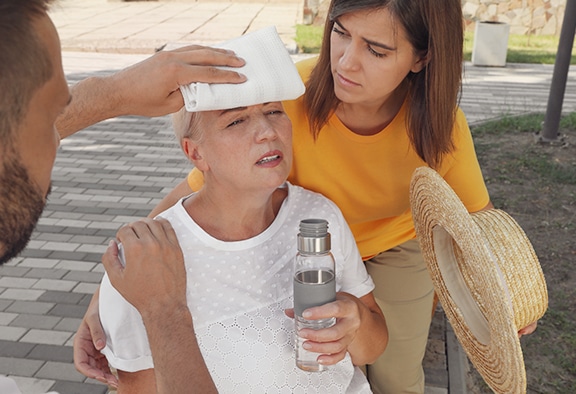
Summer is one of the most enjoyable times of the year. Still, it can also pose extra health challenges—especially for people with diabetes. If you’ve been wondering “does heat affect diabetes?,” you should know that warm weather can have an impact on your diabetes management strategy.
People living with diabetes are particularly susceptible to the effects of warm, humid weather, but that doesn’t mean you can’t enjoy some fun in the sun during the summer months. You’ll just need to take some basic precautions first. This is the ADS guide to heat, humidity, and diabetes.
Here’s How Heat Can Affect Diabetes Patients
Scorching heat can make anyone feel unmotivated, but the effects of warm weather go beyond that for many people with diabetes. People who have this condition usually get dehydrated more quickly than people who don’t—and the heat certainly doesn’t help. On top of that, dehydration can result in elevated blood glucose levels, making diabetes management even more difficult.
If you’re dealing with mild or moderate dehydration, you might notice symptoms like:
- Fatigue
- Elevated thirst
- Headaches
- Reduced urination
- Lightheadedness/dizziness
- Dry eyes and mouth
However, dehydration can get worse if left alone for too long. In that case, you could find yourself dealing with these severe dehydration symptoms:
- Intense thirst
- Low blood pressure
- Dark urine
- Rapid heartbeat
Dehydration is a significant concern for people with diabetes. Still, it’s not the only way hot weather can get in the way of diabetes management. Diabetes patients are also at risk of heat exhaustion since diabetes can result in nerve damage. Unfortunately, that includes the nerves in your sweat glands—meaning your body may not be able to cool itself as effectively as it should.

Intense heat can even change how you respond to insulin. Typically, physical activity will reduce your insulin requirements. Hot weather can make this less predictable, putting you at risk of both high and low blood sugar levels. If that’s the case for you, ask your healthcare team about adjusting your insulin dosage during the summer.
In Diabetes Health, It’s Not (Just) the Heat; It’s the Humidity
All of the symptoms described above have one thing in common: they’re caused by high temperatures. Of course, summer weather also comes with higher levels of humidity. That added moisture in the air can make the heat feel even more intense.
Along with that, humidity makes it harder for liquids (for example, your sweat) to evaporate. Because of that, you may find it more challenging to stay cool and keep your blood sugar in range when it’s humid out. Since the heat index considers both humidity and temperature, keeping an eye on this statistic in your area is an excellent way to understand the conditions you’ll need to deal with.
Warm Weather Diabetes Management Tips
While heat and humidity present added challenges for people with diabetes, these challenges aren’t insurmountable. Here’s how you can protect yourself and enjoy your summer:
- Get enough water. The key to avoiding dehydration is maintaining a high fluid intake. As always, people with diabetes should avoid sugary beverages.
- Steer clear of alcohol. Alcoholic beverages can make you need to urinate more frequently than average—which means you’ll lose fluids in the process.
- Seek out shade. The heat index can be higher in direct sunlight than it is in shady areas.
- Double-check your meds. Some medications have warnings about heat. The instructions included with your prescriptions will tell you what to do.
- Dress right. Are you planning to spend time outdoors? If so, be sure to wear loose-fitting, light clothes.
- Keep an eye on your glucose levels. Hot weather can make blood sugar levels fluctuate more than expected. Be ready to test your glucose regularly, especially before and after physical activity.
- Exercise indoors. Outdoor workouts can be enjoyable, but exercising in air-conditioned spaces will help you minimize the effects of heat and humidity.
- Look out for DKA. Diabetic ketoacidosis is a serious diabetes complication associated with extremely high blood sugar. Since diabetes management can be trickier in the summertime, make sure you have ketone tests on hand to check for DKA.
Protect Your Diabetes Supplies From the Heat
Your diabetes supplies can be affected by warm weather, too. Because of that, you should protect these valuable items by:
- Taking care not to leave your glucose meter, insulin pump, and other supplies in direct sunlight or a hot car
- Storing test strips and diabetes supplies in a cool, dark place
- Keeping your insulin in a cooler while you travel (but not putting ice packs on top of it)
Watch Out for These Symptoms
In addition to the conditions you’ve already read about, it’s wise to look out for heat exhaustion, hypoglycemia, and hyperglycemia. The symptoms associated with these health issues can overlap, but they all require attention—and, in some cases, professional care.
Heat Exhaustion In Those with Diabetes
When your body overheats, you could find yourself dealing with a condition called heat exhaustion. The symptoms of heat exhaustion include:
- Lightheadedness
- Dizziness
- Headache
- Muscle cramps
- Low blood pressure
- Excessive sweating
- Nausea
- A weak, rapid pulse
- Cool/moist skin (even in warm weather)
Heat exhaustion isn’t an emergency in the same way heat stroke is, but the former condition can precede the latter. Because of that, you shouldn’t ignore the possibility of heat exhaustion.
Hypoglycemia In Those with Diabetes
Though diabetes is often associated with excessive blood sugar, dangerously low glucose levels can also be a concern. This situation is known as “hypoglycemia,” and it officially begins when your blood sugar goes below 70 mg/dL. Since your metabolism will run higher and your insulin absorption will increase in warm weather, your hypoglycemia risk will naturally increase during the summer.
Keep an eye out for hypoglycemia symptoms, including:
- Confusion
- Blurry vision
- Anxiety
- Tremors
- Sweating
- Heart palpitations
Hypoglycemia can cause loss of consciousness if left untreated. To avoid this, bring glucose tablets or another fast-acting carb with you to consume in the event of falling blood sugar levels.
Hyperglycemia In Those with Diabetes
Excessively high blood sugar, or “hyperglycemia,” is still a threat to people with diabetes in warm-weather conditions. This condition officially kicks in when your blood sugar exceeds 180 mg/dL (after eating) or 130 mg/dL (before meals).
Common symptoms of hyperglycemia include excessive thirst and fatigue. Both of these symptoms can also be tied to dehydration, but you should consider the possibility of hyperglycemia, too. When you spot these symptoms, check your blood sugar level and re-evaluate your fluid intake.
What To Do in an Heat-Related Diabetes Emergency
When you notice signs of dehydration or heat exhaustion, try not to panic. Instead, stop what you’re doing and head inside to cool down. There, you should drink plenty of fluids and do a fingerstick test (or check your continuous glucose monitoring system).
Are your blood sugar levels below 70 mg/dL? In that case, follow the 15-15 rule: eat or drink 15 grams of fast-acting carbs and test your levels again once 15 minutes have passed. Conversely, take quick-acting insulin if you find that your blood glucose levels are elevated.
On the other hand, your blood sugar levels may be extremely high. In this situation, arrange for someone to take you to the hospital for treatment. Low insulin levels and dangerously high blood glucose levels could result in DKA if left unchecked.
Keep Cool With Help From ADS
So, does heat affect diabetes? Of course it does—if you have diabetes, summer weather can make it more difficult than normal for you to manage this condition. Because of this, it’s a good idea to plan ahead and keep a close eye on your symptoms and blood sugar level.
Furthermore, you’ll need access to a few different supplies to manage type 1 or type 2 diabetes successfully. These include insulin, diabetes testing supplies, and CGMs. All these products and more are available online through ADS, allowing you to focus on having fun and taking care of yourself this summer!
